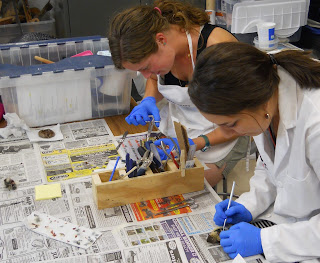Taxidermy Week
As collections staff prepare for a taxidermy crash course with
summer interns this week, I find myself looking back on a personal
journey from a child unable to even look towards roadkill to an adult who guts
mice and quail on a weekly basis to feed to our living collections. My respect for
animals has not faltered, but I am more readily willing to understand them
through new perspectives. Friends and family smirk when told of this new
practice, and the average Museum visitor often works through disgust to inquire about
the details of animal preservation.
I always expected to reach the point in school when I’d
have to refuse to kill the frog which our biology class would inevitably
dissect. That point never came—we instead were shipped pre-euthanized rats and
the following year watched on as an eccentric teacher cut open a pregnant pig.
I was disgusted but couldn’t look away. I never expected to take up such a practice, but taxidermy has become another way for me to experience and understand the natural world. The current interns will soon try their hands at some red crossbills and I an owl. Let's hope that this experience proves as meaningful for them as it has me.
I grew up exposed to the art of taxidermy largely from afar.
My father inherited a deer mount with a plaster form that lived in our basement, which I noticed only in my childhood periphery. I had an affinity for museums
from a young age and while I admired the specimens in natural history
institutions, I paid little mind to how they actually came to be preserved.
As it turns out, taxidermy has historically involved
questionable materials and practices. Ancient Egyptians practiced animal
preservation yet had little concern for how the subjects would appear during
later observation. People of the Middle Ages likewise experimented with methods
to preserve the dead. Taxidermy as a practice did not become widespread until a few hundred years
later, when sawdust, rags, and arsenic were often used.
 |
| As interns, Kellie and I worked diligently to taxidermy wild canaries. |
Arsenic helped to dry out the skin and prevent insect infestation
in taxidermy mounts up until rather recently. The substance has always been synonymous with danger in my mind, but I hadn't knowingly experienced it until my first internship with the Museum. All specimens to this date have been tested for traces of arsenic, and those testing positive are marked with red tags reading "ARSENIC" in bold lettering. Many of these mounts were created decades ago by our first director or others during her time. Nowadays, we wear gloves and masks when handling arsenic-preserved specimens, and substances like Borax have taken its place in taxidermy studios.
We've traded in other materials as well. Taxidermists used to stuff animal skins with sawdust or stretched skins over forms made of wound up string. Today, one may find anatomically accurate foam molds and plastic eyes of various animals in a Van Dyke's or McKenzie Taxidermy Supply catalog. Taxidermy practices have changed over time but all was completely new to me just a few years ago.
During my first summer internship I encountered what I now affectionately refer to as "Taxidermy Week." Interns and the Curator joined our Collections Monitor, John Kudlas, in the Museum workshop and spent two days attempting to taxidermy wild canaries to his standards. I think I failed. The experience was invaluable however, as it exposed me to the inner anatomy of a creature that once lived in the forests that I now too call home. I studied the intricate details of the ovenbird's physical being and at the same time gained an appreciation for the art of taxidermy. It is indeed an artform--one that I admittedly dismissed when it showed up as a result of an online career assessment I took as a teen.
 |
| Modern forms for squirrels, pheasants, and grouse. |
During my first summer internship I encountered what I now affectionately refer to as "Taxidermy Week." Interns and the Curator joined our Collections Monitor, John Kudlas, in the Museum workshop and spent two days attempting to taxidermy wild canaries to his standards. I think I failed. The experience was invaluable however, as it exposed me to the inner anatomy of a creature that once lived in the forests that I now too call home. I studied the intricate details of the ovenbird's physical being and at the same time gained an appreciation for the art of taxidermy. It is indeed an artform--one that I admittedly dismissed when it showed up as a result of an online career assessment I took as a teen.
 |
| We attempted ovenbird taxidermy during my second summer internship. I don't believe this was done to the Collection Monitor's standards either. |